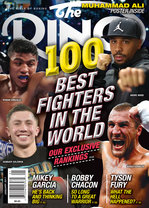The King and I: The greatness of Larry Holmes
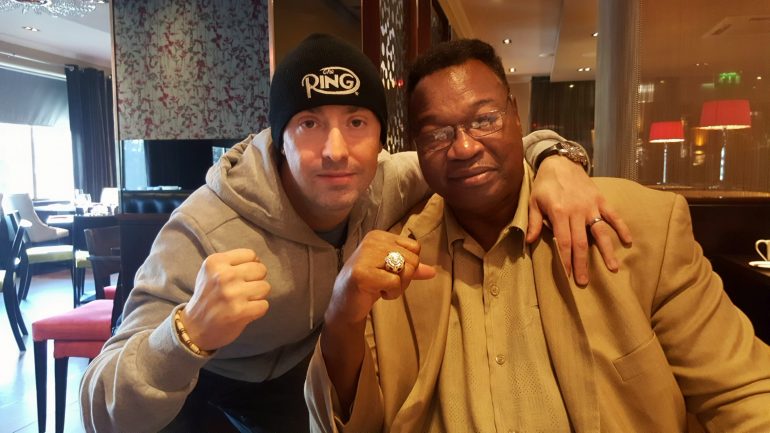
“Have you ever been in Motherwell, Larry?”
It wasn’t yours truly asking that question. This was an ice breaker from the master of ceremonies at the Dalziel Park Hotel in Motherwell, Scotland. Larry Holmes, the legendary former heavyweight champion, who ruled the glamour division with an iron jab for almost 7½ years, was in attendance as special guest and a crowd of 100 or so fans greeted him enthusiastically.
Motherwell, which is about 15 miles outside of Glasgow, just happens to be my home town. In September, I’d found out that Holmes would be stopping off here during his U.K. tour and immediately went into overdrive in the hope of arranging an interview. I called his office. No dice. I called his house. No answer. I called his cellphone. Bingo.
“Larry?”
“Yeah!”
“It’s Tom Gray from RING Magazine. You’re coming to Scotland, right?”
“Yeah, I’m coming there to kick all your asses!”
“Larry, you’re not only coming to Scotland, you’re coming to Motherwell and that’s where I live. I need to see you. I need an interview. Help me!”
“Great, I’ll kick your ass first!”
The first time I recall seeing Holmes in action was in the early 1990s. A friend came to my house with a video called Champions Forever and within 90 minutes, I’d gone from boxing fan to boxing super-freak. The documentary focused on the five-way rivalry between Muhammad Ali, Joe Frazier, George Foreman, Ken Norton and Holmes. If you haven’t seen it, then you owe yourself a treat because this is as good as it gets.
Ali is the main player during the feature and I marveled at his talent. I’d never seen such speed and grace in a boxing ring. Sonny Liston humiliated twice. Frazier beaten twice. Norton beaten twice. Foreman schooled. Revenge over Leon Spinks. Hold up? Who is this guy beating the living sh-t out of Ali in Las Vegas? It was Larry Holmes.
I couldn’t stand the guy who had ruined my new hero, ruined the ending to a great documentary and ruined my entire day. And I couldn’t get the images of a faded Ali being picked apart out of my head for weeks.
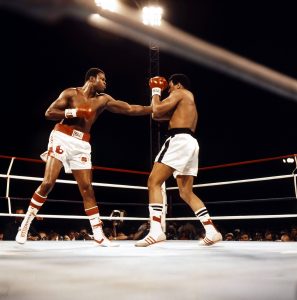
Holmes (left) tags Muhammad Ali. Photo: THE RING
Holmes has heard anecdotes similar to this one for decades. The morning after his encounter with Scottish boxing fans, he knowingly nodded his head at the breakfast table before addressing the hate campaign that fans waged against him following his 11th-round stoppage of Ali in October 1980. “I paid it no mind,” said the former champion. “As much as I cared about Muhammad Ali, it was still him or me. I wanted to make sure that he didn’t beat me up, so I had to beat him up.
“I was mean when I had to be mean. I could turn it on and turn it off, and I did what I had to do that night. If Ali made me mad, which he was trying to do in the fight, I’d worry about beating up on him. Afterwards, I went to his dressing room to make sure he was alright. If I didn’t care, then I wouldn’t have done that.
“The man had helped me and did a lot of things for me. Ali gave me a job (as a sparring partner) and I spent quality time with him. Ali and Joe Frazier (who Holmes also sparred) were an enormous influence because they were champions and I wanted to be around champions. I wanted to see what champions could do and how they acted. I wanted to be around people I admired.”
For a long time, I had no admiration for Holmes whatsoever but I was hooked on the sport. I began collecting fights: Ali, Frazier, Foreman, Norton, Joe Louis, Sugar Ray Robinson, Sugar Ray Leonard, Marvelous Marvin Hagler, Thomas Hearns, Roberto Duran, Julio Cesar Chavez, Pernell Whitaker. Anyone not named Larry Holmes.
This was long before the internet arrived and the comfort blanket of YouTube was about 15 years away. If you wanted to see boxing at its best, then you sent for VHS video tapes. And that was not cheap. Opportunists could charge £20 ($30) for a bootlegged three-hour tape. Sometime you would get lucky and the quality would be excellent. Sometimes you had to squint your eyes to view an eighth-generation copy.
Holmes punched his way back into my boxing obsession when I came across a book named “Serenity“, which was written by the late Ralph Wiley and published in 1989. I had read all nine chapters, some 230 pages, at Motherwell Library but I wanted to take it home. The library refused to sell it, so I had my mother borrow the book and conveniently forgot to take it back. Fortunately for me, the library was undergoing renovation and was at a temporary address. When they were back up and running, my infringement had gone unnoticed. I was officially a thief.
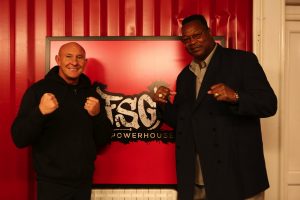
Holmes visited The Fighting Scots Gym in Bellshill, Scotland, during his stay.
Although he covered far more wide-reaching topics, as well as other sports, Wiley was a terrific boxing guy. He remains one of the finest writers I have ever come across. Every chapter in “Serenity” is engrossing and the one on Holmes, entitled “A Workman’s Compensation,” forced me to turn a corner. If Wiley appreciated Holmes and spoke of him with such glowing admiration, then I was clearly making a mistake by ignoring that.
I ordered tapes of Holmes for months: Norton, heavyweight hellfire to win the WBC title in June 1978; Earnie Shavers, schooled twice; Ossie Ocassio, decked by a jab; Tim Witherspoon, arguably the finest heavyweight boxing match of the 1980s. Hell, I even purchased a full copy of the Ali fight, so there was no holding back now.
The performance I most enjoyed, however, was Holmes’ third-round destruction of Leon Spinks, which took place in June 1981 in Detroit. I’d watched Ali split two 15-round fights with Spinks from 1978 but even though he’d regained the WBA heavyweight title in the rematch, “The Greatest” was clearly over the hill and rolling down the other side.
Holmes, by comparison, was punch-perfect and did to Spinks what a younger version of Ali would have.
“Leon always stayed right in front of you and all I had to do was time him moving his head on the way in,” said Holmes, as he mimicked Spinks’ side-to-side defense. “As soon as he moved his head to his right, I nailed him with the right hand and that was that.
“I dedicated myself to kicking his ass because I didn’t like him. I was at a dinner (before the fight) and my wife wanted Joe Louis’ (signed) boxing gloves that were on our table. (Spinks) came over from his table, took the gloves and said he wouldn’t give them back. I beat his ass for that but I felt bad afterwards.”
If “Neon Leon” was Holmes’ finest performance, then what was his best moment as champion? For me, it’s difficult to see past Gerry Cooney. Holmes may not have been blessed with hordes of Hall of Fame opponents during his championship run but he took on several of the best big men in the world. The unbeaten Cooney, a left-hook destroyer, was “The Great White Hope” and a major threat to the title.

Holmes (right) and Gerry Cooney trade blows. Photo: THE RING
Holmes’ impressive 13th-round stoppage of Cooney bolstered his resume but “The Easton Assassin” had liquidated much more than a gutsy challenger. He overcame a repulsive undercurrent of racism. He overcame death threats. He overcame the disrespect of being introduced first during pre-fight pageantry. He overcame two shocking scorecards that had the fight close after 12 rounds (113-111 Holmes), despite scoring a knockdown and Cooney being deducted three points for low blows.
If Ali had “shook up the world” like that against Cooney, the fight would have been the subject of a Hollywood movie a long time ago. “Gerry was the big white guy who could punch and everyone was betting on him,” recalled Holmes with a smile. “I’d fought at Caesars Palace many times and the gamblers were usually all for me. Suddenly, Gerry Cooney comes in and takes over the whole town. What happened to Larry Holmes? Oh, he’s gonna get his butt kicked. Just put him in the back.
When I asked if that fired him up, Holmes leaned forward, ‘No, that’s what they wanted,” he hissed. “They wanted me to lose my cool so that I would go in there and lose the fight. All those rumors about the President (Ronald Reagan) wanting to call Cooney in the dressing room if he won. I didn’t care about any of that. If you want to congratulate him, then congratulate him on his ass whipping because that’s all he’s gonna get.”
Holmes successfully defended his heavyweight championship 20 times over. He lost the WBC belt to politics in 1983 and quickly aligned himself with the newly-formed IBF, but Holmes remained THE RING and linear heavyweight champion until September 1985.
When I viewed a worn-out copy of light heavyweight champion Michael Spinks outpointing Holmes over 15 rounds, I was left unfulfilled. It had been a poor fight, although the real fireworks came afterward when a devastated Holmes infamously stated that Rocky Marciano couldn’t carry his jockstrap. “The Rock” had been the subject of Holmes’ wrath because he had failed to equal Marciano’s legendary 49-0 unbeaten streak by one single victory. Holmes was being heckled by the late former champ’s family at a post-fight press conference and he hit back — hard.
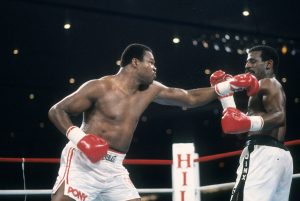
Holmes (left) attacks Michael Spinks in their rematch. Photo: THE RING
Despite now being a former champion, Holmes bowed down to no one.
I obviously knew the result of the Michael Spinks rematch before viewing it but as each round passed, my confusion grew. A much more aggressive Holmes appeared to be kicking “The Jinx’s” ass all the way back down to light heavyweight, but after 15 rounds the judges found a way to deprive him. Spinks claimed a controversial split decision in April 1986.
Holmes, remarkably, would fight on for another 16 years and compete for the heavyweight championship of the world on three more occasions. He lost by knockout, for the only time in his career, to Mike Tyson and dropped decisions to Evander Holyfield and Oliver McCall. He retired at the age of 52 years old with final career stats of 69-6 (44 KOs).
Would he have continued had the Spinks rematch gone his way?
“I really don’t know because I fought for money,” Holmes said after some deliberation. “I didn’t fight to be the heavyweight champion of the world. I didn’t fight to say I kicked someone’s ass. I didn’t fight for bragging rights. I got into fighting to make money and while it’s great to be heavyweight champion of the world, it ain’t great being broke.
“If you’re broke, you get called a broke champion. If you’re rich, they call you a rich champion. Who wants to be a broke champion? I wanted to go in the ring and get out with some money in my pocket. I wanted money that would last me for the rest of my life and so far, I’m doing it. I’ve got a few more years to go. I just turned 67 years old and what amazes me is that I can do just as much as anybody else. I don’t feel that boxing affected me.”
It didn’t. Holmes reminisces about fights, in detail, from as early as 1973 effortlessly. The sport that changed his life, gave him greatness and provided an immortal legacy has left no ill-effects. The former champion is not in perfect health, however. He has been battling Type 2 diabetes since 2013, but with the help of his loving wife of 36 years, Diane, and the support of his family, he is taking every precaution to maintain a healthy lifestyle.
For me personally, I am not the most experienced writer on the block. Far from it. However, I have been lucky enough to interview great fighters: Frazier, Foreman, Leonard, Duran, Hagler, Hopkins, De La Hoya, Lewis — and the list goes on. This breakfast time interview with Holmes, however, will always be with me for a different reason. Unlike the other Hall of Fame fighters I’ve encountered, I once looked upon Holmes with disdain but grew to appreciate him as much as any champion who has yet lived.
To fans, his body of work is like an expensive painting that becomes more valuable with each passing year.
From countless hours of VHS video, to halcyon days at the local library, my journey with “The Easton Assassin” went full circle and ended with a one-on-one encounter just minutes away from where it all began, almost 25 years ago.
Many thanks to James Ward, who works for both Goldstar Promotions and the European Boxing Federation (EBF), for his assistance in arranging this interview.
Look out for a separate Q&A with Larry Holmes, which will be published in the very near future.
Tom Gray is a UK Correspondent/ Editor for RingTV.com and a member of THE RING ratings panel. Follow him on Twitter: @Tom_Gray_Boxing
Struggling to locate a copy of RING magazine? Try here or…
SUBSCRIBE
You can subscribe to the print and digital editions of RING magazine by clicking the banner or here. You can also order the current issue, which is on newsstands, or back issues from our subscribe page. On the cover this month: THE RING 100.


